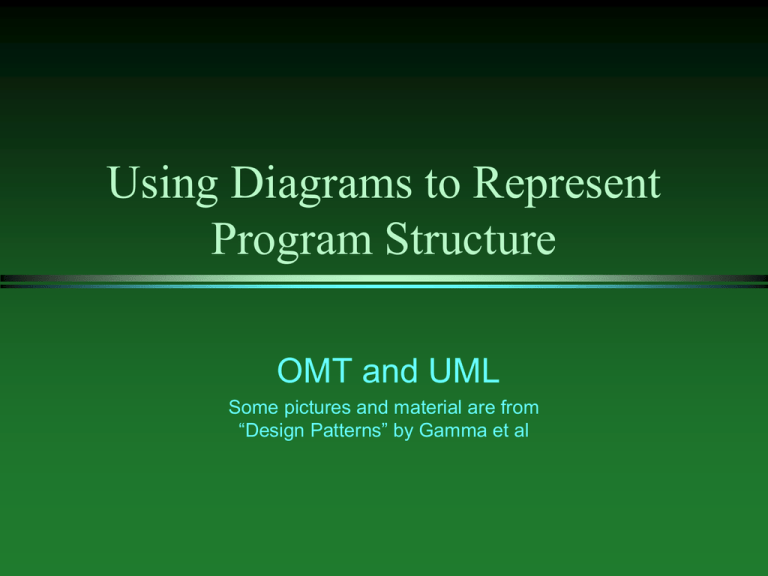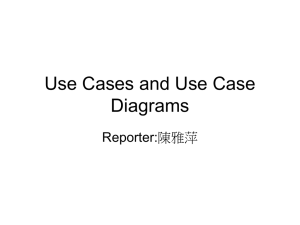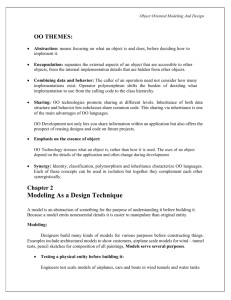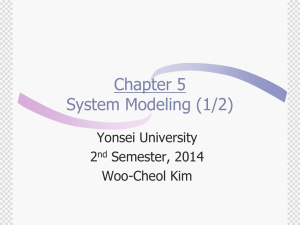representing program structure with diagrams
advertisement

Using Diagrams to Represent
Program Structure
OMT and UML
Some pictures and material are from
“Design Patterns” by Gamma et al
Outline
why diagrams
diagram types
class diagram elements
class
aggregation
inheritance
instantiation
class diagram examples
object diagram
use case diagram
interaction diagram
2
Why Diagrams
diagrams is a way to capture the essential aspects of the
program
have an overview of the whole program
see the important relationships between elements of
program
get the picture of the program before it is coded
standardized as part of
object modeling technique (OMT) – Rumbaugh, Blaha, et
al 1991
universal modeling language (UML) – Rational Rose Inc.
and other companies
used in program planning, development and documentation
language independent (not necessarily C++)
3
Diagram Types
structure diagram – emphasizes what constructs must
be present in the modeled system
class diagram – the system classes, attributes, their
relationships
object diagram – a view of the modeled system at
a specific execution instance
behavior diagram – emphasizes what actions must
happen in the system
use-case diagram – system functionality in terms of
interaction with outside actors
interaction diagram – flow of control and data
among constructs
4
Classes
ClassName
instVar1: Type
instVar2: Type
oper2(): returnType
oper1(parName: parType): rType
operations – member functions/methods
instance variables – member
variables/attributes
Example
c: char
str: string
showchar(): void
getstring(): string
class Example{
public:
void showchar();
string getstring();
private:
char c;
string str;
};
class BankAccount{
public:
void deposit(dollars amount);
void withdrawal(dollars amount);
private:
string owner;
dollars balance;
};
5
Aggregation
if class contains instances (objects) of other classes the
class aggregates them
if class aggregates more than one instance of the same
class it is shown diagramatically
multiplicity - shows how many instances of objects on each side
6
Inheritance,
Reference and
Instantiation
Class inheritance
class contains a reference to another
Additional comments
object creation (class instantiation) is
done by a method of another class
7
Visibility
- private member
+ public member
8
Example Class Diagram 1
9
Example Class Diagram 2
10
Example Class Diagram 3
blah
11
Object Diagram
shows objects and references as the program is executed
what would be a class and an object diagram for an object with
dynamically allocated members?
12
Use Case Diagrams
written description of the
system’s behavior
regarding tasks or
requirements
captures interactions
between actors (outside
entities) and the system
through use cases
actor
use case
13
Interaction (Sequence) Diagram
shows order in which requests (methods) between objects are executed scenario, typically within a single use case
boxes – processes (function invocation) in each object
lines – messages (interaction) between objects
lifeline – vertical dashed line represents objects’ existence
14
Interaction Diagram Examples
15
Interaction Diagram Examples 2
16
Questions on Diagrams
What is the purpose for the use of diagrams
What is the difference between structure and behavior diagrams?
What types of structure diagrams we have studied? Behavior
diagrams?
How is class denoted on a structure diagram?
What is aggregator/agregatee? How is their relationship denoted?
What is multiplicity and how is it denoted?
What is visibility and hwo is it denoted?
How are objects denoted on an a structure diagram?
What diagram uses use cases, actors? What is system boundary?
What do boxes and lines and crosses represent in a flow diagram?
17











